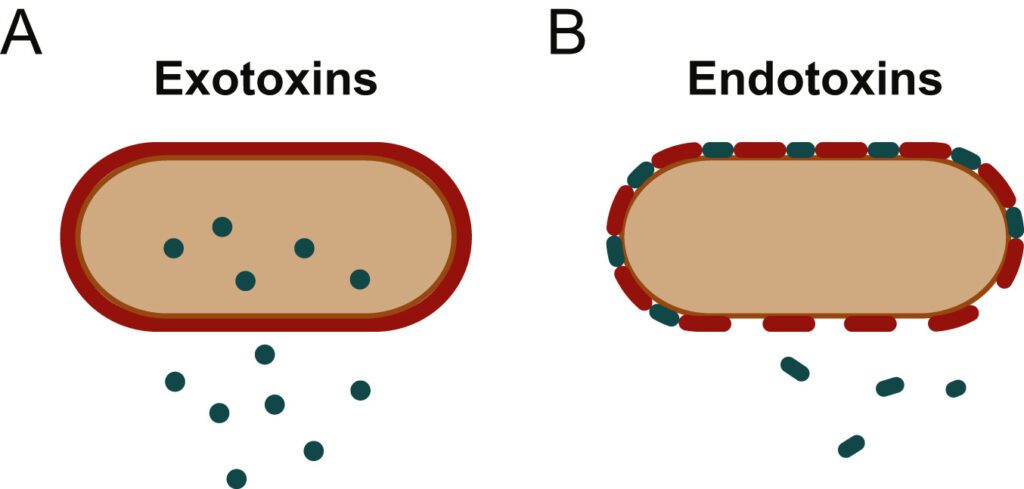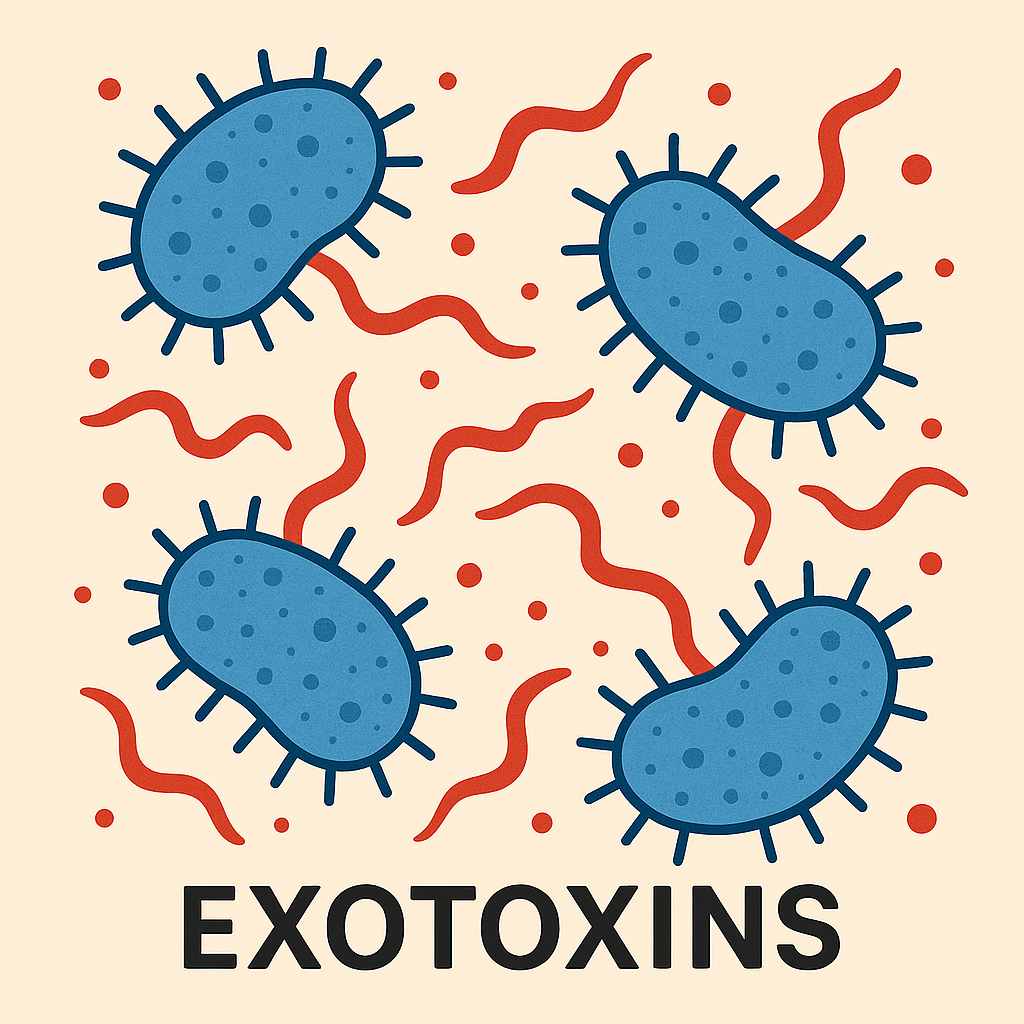What Is Exotoxin and Endotoxin?
Exotoxin and endotoxin are two types of bacterial toxins that differ in their origin, structure, and effects on the host. Exotoxins are proteins secreted by living bacteria, typically Gram-positive species, and are highly potent, causing specific diseases like tetanus or diphtheria. In contrast, endotoxins are lipopolysaccharides (LPS) found in the outer membrane of Gram-negative bacteria, released only upon cell lysis, and trigger generalized inflammatory responses like fever and septic shock.
While exotoxins can be neutralized by antibodies and often have vaccine targets, endotoxins are more heat-stable and provoke strong immune reactions that can lead to life-threatening conditions. Both play significant roles in bacterial pathogenesis but through distinct mechanisms of toxicity.
Summary of Exotoxin and Endotoxin

- Exotoxins are harmful proteins released by live bacteria (mostly Gram-positive) and cause specific, severe effects like paralysis or diarrhea even in small amounts.
- Endotoxins are part of the outer wall of Gram-negative bacteria and are released only when the bacteria die, leading to general symptoms like fever and inflammation.
- Exotoxins can be used in vaccines (after weakening), while endotoxins cannot, and knowing their differences helps in proper disease treatment and prevention.
Table of Contents
What is Exotoxin?

Exotoxins are poisonous proteins that certain bacteria actively release into your body like tiny biological weapons. They cause specific, often severe damage (e.g., botulism paralyzes nerves, cholera triggers extreme diarrhea). Luckily, many exotoxins can be blocked by vaccines or treated with antitoxins.
What is Endotoxin?

Endotoxins are like hidden “bacterial grenades” they’re toxic bits stuck in the outer shell of germs like E. coli and Salmonella. The danger only explodes when these bacteria die and fall apart, flooding your body with substances that can cause:
- High fevers
- Dangerous blood pressure drops
- Whole-body inflammation (septic shock)
Difference between Exotoxin and Endotoxin in Microbiology
| No. | Aspect | Exotoxin | Endotoxin |
|---|---|---|---|
| 1 | What are they? | Like venom that bacteria purposely make to attack us | Like toxic dust that flies out only when bacteria die and explode |
| 2 | Who makes them? | Mostly “Gram-positive” bacteria (the kind that turn purple in tests) | Only “Gram-negative” bacteria (turn pink in tests) |
| 3 | Made of… | Proteins (like tiny poison darts) | Fat-sugar combo called LPS (like toxic glitter) |
| 4 | How strong? | SUPER strong – a tiny drop can kill | Not as strong, but still dangerous in big amounts |
| 5 | What they do | Cause specific problems: • Lockjaw (tetanus) • No-pee diarrhea (cholera) • Can’t move (botulism) | Cause general problems: • High fever • Whole-body fire (inflammation) • Dangerously low blood pressure |
| 6 | Give you fever? | Usually no fever | ALWAYS cause fever (that’s their signature move) |
| 7 | Can we vaccinate? | YES! (Tetanus shot, diphtheria vaccine) | NO vaccines exist (too tricky to target) |
| 8 | Cooking kills them? | Most die when cooked (like how heat kills germs) | SURVIVE cooking (need crazy hospital-level heat) |
| 9 | Travel in body | Can move far from infection (like tetanus toxin crawling to your spine) | Mostly stay where bacteria died |
| 10 | Antidotes? | Have special medicines (antitoxins) to block them | No direct medicine – doctors just help your body cope |
| 11 | Example sicknesses | • Tetanus (muscle lock) • Food poisoning (vomiting) • Whooping cough | • Septic shock (body meltdown) • Bad UTI complications • Typhoid fever |
| 12 | Speed of attack | Fast – can hit within hours | Slower – takes more time to cause big trouble |
| 13 | How tested? | Special lab tests (like toxin fingerprinting) | Uses magical horseshoe crab blood that clots around toxins |
| 14 | Treatment | 1. Antitoxin (blocks poison) 2. Antibiotics (kills bacteria) | Just support the body: • IV fluids • Oxygen • Blood pressure meds |
| 15 | Where instructions are | On bacteria’s “USB sticks” (easy to share between germs) | In bacteria’s “main computer” (hard to copy) |
| 16 | Immune system reaction | Teaches body to make antibodies (like a wanted poster) | Makes immune system PANIC (like a fire alarm stuck on) |
| 17 | More examples | • Stomach bug vomiting • Scarlet fever rash | • Meningitis complications • Some pneumonia after-effects |
| 18 | Heat resistance | Die at normal cooking temps (60°C+) | Need autoclave heat (121°C – like a science oven) |
| 19 | How released | Bacteria spit them out on purpose | Only come out when bacteria burst open |
| 20 | Danger dose | A grain of salt-sized amount can kill | Need teaspoon-sized amount to be deadly |
Similarities of Exotoxin and Endotoxins
- Both Exotoxin and Endotoxins are produced by bacteria – They are toxic substances made by bacteria that can harm the human body.
- Both Exotoxin and Endotoxins can cause disease – Whether released during life (exotoxins) or after death (endotoxins), both can lead to illness and sometimes serious health problems.
- Both Exotoxin and Endotoxins trigger immune responses – The body reacts to both exotoxins and endotoxins by trying to fight them through the immune system, often causing symptoms like fever or inflammation.
Conclusion
In simple terms, exotoxin and endotoxins are two different types of poisons made by bacteria, but they behave very differently. Exotoxins are active poisons released by certain bacteria while they are alive. They are proteins that can cause very specific and dangerous effects in the body, like muscle paralysis or diarrhea, even in tiny amounts. They are also used in vaccines after being made harmless. On the other hand, endotoxins are part of the outer wall of Gram-negative bacteria and are released only when the bacteria dies.
They cause general symptoms like fever and weakness by over-activating the body’s immune system. They are less toxic but harder to neutralize and cannot be used in vaccines. Understanding the differences between them helps doctors treat bacterial infections more effectively and helps scientists create better medicines and vaccines to protect us.
Frequently Asked Questions (FAQs)
What is the main difference between exotoxins and endotoxins?
Exotoxins are proteins released by live bacteria, while endotoxins are part of the outer wall of Gram-negative bacteria and are released when the bacteria die.
Are exotoxins more dangerous than endotoxins?
Yes, exotoxins are usually more dangerous because even a tiny amount can cause serious effects, like nerve damage or paralysis.
Can exotoxins and endotoxins be used in vaccines?
Exotoxins can be made harmless and used in vaccines, but endotoxins cannot be used in vaccines because they don’t create strong immunity.
Related Articles




